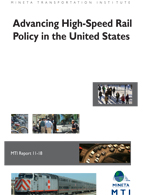- 408-924-7560
- mineta-institute@sjsu.edu
- Donate
Advancing High-Speed Rail Policy in the United States
This report builds on a review of international experience with high-speed rail projects to develop recommendations for a High-speed rail policy framework for the United States. The international review looked at the experience of Korea, Taiwan, China, and several countries in Europe. Countries in Asia and Europe have pursued high-speed rail (HSR) to achieve various goals, which include relieving congestion on highway networks, freeing up capacity on rail network for freight train operations, and reducing travel time for travelers. Some of the key rationales do not work well in the US context. As an example, in the US, freight companies own most of the rail network and, hence, do not need government intervention to free up capacity for their operations.
We concluded the potential to reduce travel times coupled with improved travel time reliability and safety will be the strongest selling points for HSR in the US. HSR lines work best in high-density, economically active corridors. Given that there are a limited number of such corridors in the US, our study recommends the US HSR project funding mix be skewed heavily toward state bonds guaranteed by the federal government. This will ensure that the states that benefit directly from the projects pay most of the costs, making it more palatable to states that may not have HSR projects. For the projects that span multiple states, member states may have to negotiate the level of financial responsibility they will bear, and this will require detailed negotiations and financial setups that are not addressed in this report.
Other measures the federal government needs to put in place include designating a key agency and dedicated funding source, and developing regulations and specifications for HSR design and construction. States that embark on HSR projects should start with formal legislation and put in place structures to ensure sustained political support throughout the planning and construction of the project. The federal government also needs to move quickly to foster educational and training centers to build up the HSR workforce in the country.
SENANU ASHIABOR, PhD
In addition to being an MTI researcher, Dr. Ashiabor also works at Dowling Associates in Oakland. He has been involved in several interesting transportation planning and modeling research projects over the past ten years. Dr. Ashiabor is an active member of the Transportation Research Board (TRB) and was on the ACRP panel developing the Guidebook for Conducting Airport User Surveys. He has authored/coauthored six peer-reviewed publications and presented his work at several technical conferences. Prior to joining Dowling Associates, he was a researcher at the Virginia Tech Air Transportation Systems Laboratory.
WENBIN WEI, PhD
Dr. Wenbin Wei is a professor in the Department of Aviation and Technology at San Jose State University College of Engineering. He received his PhD in transportation engineering from University of California, Berkeley, with minors in industrial engineering and economics. After graduating, he worked with the California Partners for Advanced Transit and Highway (PATH), Berkeley, from 2000 until 2001, and then joined American Airlines Research Center in Fort Worth, Texas, as a research analyst. He moved back to the San Francisco Bay Area when he joined San Jose State University in August 2009. He teaches various aviation and operations research classes, mentors students, and conducts research for leading institutions, including the National Aeronautical Space Administration (NASA).
-
Contact Us
San José State University One Washington Square, San Jose, CA 95192 Phone: 408-924-7560 Email: mineta-institute@sjsu.edu






